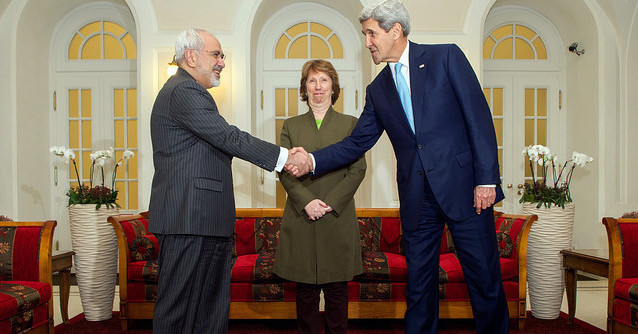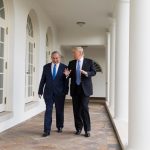by Derek Davison
The new year may have brought with it some signs of progress toward a comprehensive deal between world powers and Iran, lending credence to one of Graham Fuller’s 2015 predictions for the Middle East. However, any movement toward a nuclear agreement must now contend with a potentially game-changing complication: the desire of a new and more hawkish Republican-led Congress to impose additional sanctions on Iran regardless of how the talks are progressing.
The Associated Press reported on Friday that the P5+1 (the US, UK, France, Germany, Russia, and China) had reached a tentative agreement with Iranian negotiators on a plan to have Tehran ship some portion of its stockpiled low enriched uranium (LEU) to Russia. The agreement would presumably be along the lines of the arrangement that was first reported by IPS’s Gareth Porter in October whereby Iran’s stockpiled LEU, as well as much of its newly enriched LEU, would be converted by the Russians into fuel for its Bushehr civilian nuclear facility.
If the AP report is accurate, the deal could represent a major breakthrough in one of the core areas of dispute between the parties: the size of Iran’s uranium enrichment program. The P5+1 have sought to limit the number of centrifuges that Iran would be allowed to operate under the terms of a deal in order to lengthen the amount of time it would take the Iranians to produce enough highly enriched uranium (HEU) for a single nuclear bomb if it chose to pursue one (Iran’s “breakout time”). But Iran has balked at the idea of reducing its centrifuge program. However, another element in the “breakout time” calculation (part of the so-called “Rubik’s Cube” of a final nuclear deal) is the amount of LEU that Iran has stockpiled. Were Iran to agree to ship its LEU (which can be fairly easily enriched to levels required for weaponization) to Russia for conversion into fuel rods (which cannot be easily converted to a weaponizable form), then Iran’s “breakout time” could be extended with only a relatively minor –and perhaps even no — reduction in Iran’s current centrifuge capacity.
It should be noted that the AP report contained no specifics, saying simply that “both sides in the talks are still arguing about how much of an enriched uranium stockpile to leave Iran.” It also offered no indication that the deal would motivate the US/P5+1 negotiators to alter their demand that Iran cut its current number of operating centrifuges by over 50%, to 4500, under a final deal. In addition, Iran’s foreign ministry quickly dismissed the AP report, with spokeswoman Marzieh Afkham saying that “no agreement has been reached yet on any of the issues [being discussed] during nuclear talks,” although that denial could reflect diplomatic posturing on Iran’s part.
Other news out of Tehran, however, has offered a more encouraging sign that the sides may be moving closer to a deal. Iranian President Hassan Rouhani on Sunday argued that Iran should be prepared to accept some limits on its uranium enrichment program if doing so could help achieve a larger aim:
Speaking to an economic conference in Tehran, Rouhani both countered hard-line critics worried Iran will give up too much while also attempting to signal his administration remains open to negotiation with the six-nation group leading the talks.
If “we are ready to stop some types of enrichment which we do not need at this time, does it mean we have compromised our principles and cause?” Rouhani asked.
He responded: “Our cause is not linked to a centrifuge. It is connected to our heart and to our willpower.”
Rouhani’s remarks caused a bit of a social media storm, with some reputable analysts, including Suzanne Dimaggio who heads the Iran initiative at the New American Foundation, suggesting that a final deal is on the horizon.
Important speech by #Iran‘s @HassanRouhani today: “Our ideals are not bound to centrifuges.” Preparing for a deal. http://t.co/f9CB66RT9G
— Suzanne DiMaggio (@suzannedimaggio) January 4, 2015
Additionally, Rouhani seemed to suggest that he could put the terms of a final nuclear deal to a national referendum, possibly in order to bypass potential opposition from hardliners in the Majles (Iran’s parliament) and higher up the country’s religious and political hierarchy. As Juan Cole notes, the results of such a referendum could still be overruled by Iran’s Supreme Leader, Ayatollah Ali Khamenei, but Khamenei may be reluctant to overrule the will of a majority of the Iranian public.
Unfortunately, these positive developments take place amid the rise of a new threat to the ongoing negotiations, not from hardliners in Iran’s parliament but rather from hardliners in the newly installed (as of Saturday) US Congress. Senator Lindsey Graham (R-SC) visited Israel late last month and told Israeli Prime Minister Benjamin Netanyahu that there would be a vote on the previously stymied Kirk-Menendez bill (to impose additional sanctions on Iran) sometime in January, and that the new Congress would “follow [Netanyahu’s] lead” on dealing with Iran and the nuclear talks. Putting aside the astonishing sight of a US senator pledging allegiance to a foreign leader, sanctions are a clearly decisive issue for Tehran. The imposition of another round of broad US sanctions, even if they are made conditional on Iran abandoning the talks or breaking its obligations under the existing negotiating framework, would strengthen hardliners in Tehran who have long argued that Washington cannot be trusted. The Obama administration has pledged to veto any additional sanctions on Iran so long as talks are ongoing, but that may not matter; Senator Marco Rubio (R-FL) told reporters last week that he expects the new Congress to pass a new sanctions bill with veto-proof majorities in both the House and the Senate.
The most recent extension of the talks called for a final framework to be in place by March 1 and for a full deal to be reached by July 1. It seems likely that most Republicans in Congress will do their best to scuttle the talks before either of those deadlines can be reached, putting negotiators (who will meet again Jan 15. in Geneva) on an even tighter timeframe.






There are two points of view on sanctions, that they brought Iran to the table, and that they caused Iran to expand its nuclear program. History favors the latter view.
Regarding US “hardliners,” up until recently Obama was one. He killed the 2010 Iran nuclear swap deal with Brazil & Turkey (after supporting it). That was because of his consistent love of Israel and corresponding hatred for Iran. Obama, June 4, 2008:
Democratic presumptive presidential nominee Barack Obama vowed Wednesday he would work to “eliminate” the threat posed by Iran to security in the Middle East and around the globe. “There’s no greater threat to Israel or to the peace and stability of the region than Iran,” he told the powerful pro-Israel lobby, the American Israel Public Affairs Council (AIPAC).
And for guidance on foreign affairs Obama relies upon Joe Biden who has said: “I am a zionist.”
So Obama doesn’t have any credibility in countering “hardliners.” He can always say he tried and failed, that’s customary.
We are about to be reminded that:
“The Republicans are the party that says government doesn’t work and then they get elected and prove it.” PJ Rourke.
An entire party has hit its Peter Principle moment all at once.
With regards to these recent reports hinting that according to anonymous diplomats,Iran may agree to send nuclear fuel ro Russia,it seems this is a confirmation of a clever attempt to reach a balanced compromise on one of major remaining obstacles to a successful agreement rather than a brand new unexpected u-turn.The idea has been already aired previously in various ways.Swap scenarios have been intensively discussed in the past.Keeping an eye only on recent years, one can remind that on 24th November 2009,Ramin Mehranparast, then Iran’s Foreign minister spokeperson, had stated :” Iran does not oppose uranium going abroad”, but the debate is “how to do that”. So is this an ‘old story’? Not exactly.Rather,a path which had been explored in the past,but is now reassed not only within a new context but with a new content, including a new dimension (increasing russian involvement through building a significant number of power units in Iran).
The good news from this latest report is : said promising scenario is still valid and deserves its finetuning work.As Peter Jenkins reminds us in his excellent article on 2nd December issued in LobeLog,Russia would supply Iran with the fuel to be used in the 2 forthcoming nuclear power units ,and Iran would send most of the remaining LEU ( low enriched uranium) to Russia.
Moreover,a fuel swap was to be discussed by Moscow and Tehran with regards to 8 (?) contemplated units to be built following an agreement signed on 11th november until Iran is capable to produce at home This is indeed a critical development.
As Gareth Porter pointed out in a previous article : “The key to the new approach is Iran’s willingness to send both the existing stockpile of low enriched uranium ( LEU) as well as newly enriched uranium to Russia for conversion into fuel for power plants for an agreed period of years”. He says that a new turn in the negociations is apparent,as Marzieh Afkham, Iranian Foreign ministry spokeperson,”acknoweldged on a briefing for the Iran Press Oct.22 that new proposals combining a limit on centrifuges and the transfer of Iran’s LEU stockpile to Russia were under discussion”. However,on Tuesday 4th November,according to Iran PressTV agency,she did not confirm “politically-motivated speculations” by some foreign media. On Wednesday 19 November,Ali Akbar Salehi, head of Atomic Energy Organization (AEOI),vigorously denied reports on transfer of nuclear fuel to Russia . According to IRNA News Agency, he stated that fuel for Iran’s nuclear power plant “will be produced in Iran following signing an agreement with Russia”.He added that Russia will help Iran to produce it domestically. He repeated this in several statements : “ We will not transfer fuel outside of Iran”.
Is this the last word of the play? Answer is certainly no.On 17th December,Behrouz Kamavandi,the spokesman of the AEOI,said that Iran “may import nuclear fuel from abroad instead of producing inside “ , adding: “ If Iran can buy its needed enriched uranium at a price lower than the fuel produced inside” (Source: Trend News Agency). This is contradictory with current dogma on the non-negociable fuel-supply independence, and on its economic advantage previously pointed out as from long (2004).
So how can we understand these contradictions? First, these are not unique; they come along with others like requiring an immediate withdrawal of all sanctions (including UN) while acknowledging that this is politically,practically impossible,and would be a deleterious chock to iranian economy.Then these contradictions have to be decyphered with our well-known criteria:
i)Rohani and his fellow negociators need to bring a good big cake back home,and most importantly,face-saving.A critical factor.Then they need to show that they never and will never “surrender” ,therefore loudly claiming : ‘Iran will not export fuel”.If Russia is supposed to help Iran to produce its fuel at home,such a domestic production will not take place within a short delay.It is a rather medium-long term goal.
As we already explained elsewhere,very significant concessions may be expected from Iran if Rohani,Zarif,and the Supreme Leader can show that Iran will at least get enough extra oxygen thanks to gaining access to a fairly significant share ( $ 50bn?) of current frozen assets (+/- $100bn) together with reliefs of oil exports bans to Europe. This would bring prompt improvements to both iranian economy and people’s daily life.A domestically tradable agreement.
ii) As devil lies in details,(There are here many devils and details),even if the core idea is shared,there are still many specific aspects to be finetuned. A condition,not an obstacle.Main interest of this idea is to “kill “ the unsolvable dispute on the famous “breack-up capabiltiy” with its unmanageable debate on the ‘adequate’ number of months.Some experts have duly shown that the calculation of breack-out capacity (how many months?) is the best way for keeping intact current impasse. A swap deal will help solving this issue.
iii) Russian role is here decisive; a positive russian contribution for easing this negocation is highly welcomed by all other 5+1 colleagues (Washington included), in particular within current context of coldish relationship between Russia and the West.
iv) Moscow has astutely played a 2 dimensions party: linking a contribution to confidence-building measures with a very profitable contract for Russia which is in dire needs of fresh income together with keeping access to iranian market even if there is an agreement opening said market to the West thanks to sanctions reliefs.
On one hand this brings Iran some reassurance for meeting electricity needs.Gas production will not be exportable before several years and priority is given to domestic consumption.Increasing production of power from nuclear units makes sense.Whatever any reservation on “dual purpose”,hidden goals and sites of the iranian nuclear program.On the other hand,Tehran has obviously a deep-rooted defiance towards Russia ,together with a (recently easing) disagreement on the legal status of the Caspian Sea,and including various occasions where V.Putin did support sanctions ,delayed commissioning Bushehr,etc.
So we see a very big push is in progress on the swap chapter,but Tehran will fiercely negociate above details.It is nevertheless understandable that should iranian reactors requiring specifically russian fuel,there is a strong linkage.
At the end of the day let’s keep a cool assessment of current negociations,hoping for a preliminary political agreement by beg March.Indeed,it will be necessary to carefully select which detail are critical and need to be agreed by next 30 th June ,leaving enough room and time for ultimate finetuning of other non prioritary issues.If negociations are successful by both March and end-June, a dynamic move may be launched , allowing reasonable hope for completing what is needed.It would provide as well the necessary preconditions (not only atmosphere) for broader cooperation on regional issues once the main concern has been dealt with.
Michel Makinsky
Research Associate, IPSE ( Institut Prospective et Sécurité en Europe) ,Paris,General Manager ,Ageromys International